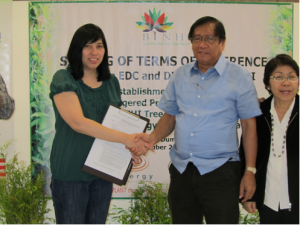EDC, DENR to Establish Philippines’ 1st Arboretum of 96 Premium Species

(PHStocks) – Geothermal leader Energy Development Corp. (PSE: EDC) and the Department of Environment and Natural Resources (DENR) will establish a seed bank and arboretum using 96 endangered Philippine tree species in Puhagan, Valencia, Negros Oriental. The 9.35-hectare arboretum will be a germplasm – a living collection of the rare, threatened, endangered indigenous and endemic prime timber species that can be a source of propagation materials in the future.
DENR Region 7 Executive Director Maxino Dichoso and EDC Senior Vice President Agnes de Jesus signed the Memorandum of Agreement (MOA) that will pave the way for the establishment of the arboretum. The arboretum will also serve as a learning and training facility for students, faculty, plant enthusiasts, ecotourists and other people of various walks of life. It will also serve as a research laboratory for biological and environmental scientists.
The EDC Arboretum will host the 96 species belonging to Dipterocarp and non-Dipterocarp families. These species are categorized into threatened, vulnerable, rare and endangered status based on the rules of DENR and the International Union of Conservation of Nature.
Dichoso lauded EDC for another groundbreaking green initiative. “This is the first arboretum initiated by the private sector that will focus on the genetic conservation of 96 endangered premium native species. It is a major effort that is consistent with the National Greening Program.”
Based on the MOA, EDC will provide the concept and design as well as the budget for the establishment of the arboretum while DENR will undertake site identification, survey and assessment of 10 hectares of forestland suitable for an arboretum within the Southern Negros Geothermal Production Field (SNGPF).
The project is a component of EDC’s landmark greening project BINHI which aims to help restore the country’s forest cover, enhance forest ecosystems, and contribute in rescuing and securing the gene pool of endangered premium Philippine timber species.
“Together with the DENR, our reforestation efforts have led to the increase in the forest cover of SNGPF by 14%. Now that the forest is protected, we are expanding the area and preserving biodiversity for climate change adaptation through BINHI,” de Jesus explained.
BINHI is aligned with the government’s National Greening Program (NGP). The arboretum project is part of the MOA on NGP. One of BINHI’s primary targets is to educate the general public about the importance of planting not just any tree but especially those that are most precious to the Filipinos’ sustainable development and national identity. Ultimately, BINHI seeks to empower the target publics so they may go the extra green mile individually or collectively.
BINHI has four major components: tree for the future, tree for life, tree for food, and tree for leisure. The tree for the future component is the flagship program of BINHI. Its aim is to recover the biodiversity of the country by establishing a tree park in every province and in selected cities and schools using prime endangered species. Fifty per cent (50%) of the seeds to be harvested from the planted trees shall then be given back to EDC which will put up a seed bank for future forests. In the future, EDC envisions that the reforestation efforts of the country will use these premium and economically important species.
The tree for life component aims to address the ecological problems of the country by establishing protection forests through assisted natural regeneration (ANR) or rainforestation farming. EDC will target to bridge the forest gaps between important mountain systems in order to avoid fragmentation of habitats of these valuable ecosystems.
The tree for food component aims to hasten re-vegetation of open and denuded forest lands and at the same time provide significant source of livelihood for the farmers living inside EDC’s geothermal reservation areas.
The tree for leisure component is intended to provide recreation, enjoyment and study sites for students, visitors and local communities while preserving the natural beauty and ambiance of the forest’s protection zone.
